INSTITUTE OF PHILOSOPHY OF NATURE
Abstract
The new fluid dynamics model justifies the revolution and rotation of orbital bodies housed within the spinning extra nuclear space structure of the nucleus celestial body. According to the new dynamics only prograde rotation and revolution is feasible. The reported retrograde rotation and revolution of celestial bodies are not supported by the new fluid dynamics model therefore questions the very observation. This author has identified the error in characterisation of retrograde motion and reported the same in this journal. The fixed inclination of the axes of planets and satellites relative to distant stars refers to relative motion without relevance to dynamics. More fundamentally the inclination of the axis is the result of two cause oriented primary motions, 1) orbital motion and 2)oscillation of the axis of the orbital body relative to the axis of the central body having the matching frequency. The latter two motions are primary because they are characterised relative to interacting celestial bodies. The mean position of the axis is near-normal to the equatorial plane of the central body. The degree of inclination of the axis is small due to low amplitude of angular oscillation. This paper introduces the fluid dynamics model and explains why the mean position of the axis is normal to the equatorial plane of the central body and why most orbital bodies have small acute angles in positive direction.
Keywords: Panchamohabhuta, Prograde Motion, Fluid Dynamics, Planet and Satellite.
Introduction
It is worth noting the Vedic concept of five basic physical constituents of the universe Panchamohabhuta and further interpretation of Ayurveda that each physical entity (Mohabhuta) is a mixture of Panchamohabhuta. Now clubbing the modern concept of four states of matter, the author came to a conclusion that mass and space are the only two basic constituents of the universe. And matter at any stage and in any domain is a mass-space integral system where both mass and space are physical entities [1]. Hence like the mass-density (mass content per unit volume) the physical space also has space-density (space content per unit volume). The dynamism of the universe and its constituents (objects) all comprising only two basic constituents (mass and space) derive their form-based interaction property from the basic formless interaction property of mass and space [1]. The identified four fundamental forces of nature (form-based/object-based fundamental interaction forces in different domains of nature) are caused due to the basic interaction of formless basic constituents (mass and space) whose existence is common to all forms of matter in all domains. The possible interactions of mass and space are: mass-space interaction (attraction), mass-mass interaction (repulsion) and space-space interaction (repulsion). The cause of gravitational attraction among material bodies is due to the basic interaction of mass-space. Following the mass-space attraction the author has derived the exact gravitational equation of Newton [2] Newtonian mass attraction gravity has problem in explaining why the atoms and molecules do not settle down to the surface of the earth but the mass-space attraction gravity explains the stability of atoms and molecules in the atmosphere. Further, the stability of a finite universe with mass-mass attraction gravity is at stake however it is not a problem for mass-space attraction gravity. According to the new concept, any referred space pocket in the extra nuclear space structure of a celestial body is a mass-space integral system where space contains less known space matter particles in finer domains. The celestial body attracts the space component present in the space pocket and the mass component of the space pocket experiences the centrifugal force. The so-called space being a space-mass integral system is a space fluid therefore experiences both gravitational force and the centrifugal force.
Any celestial body is associated with an extra nuclear space structure due to mass-space attraction. Thus, it is proper to consider the celestial body with its integral extra nuclear space structure for their dynamics in the solar system. According to this new consideration, the planets with their extra nuclear space structure move within the extra nuclear space structure of the sun. Likewise, the satellites of a planet with their extra nuclear space structures move within the extra nuclear space structure of their planet. Thus, the fluid dynamics model is more appropriate for the solar system than the existing concept of motion of bare celestial bodies in free space, ignoring their associated extra nuclear space structure. The rotating sun has a spinning extra nuclear space structure which affects the dynamics of planets for their revolution, rotation and axial oscillation. Similarly, the rotating planet has a spinning extra nuclear space structure which affects the in-house dynamics of satellites for revolution, rotation and oscillation of the axis. Any rotating celestial body has a spinning extra-nuclear space structure. The spinning space-fluid (space-mass integral system) experiences gravity and centrifugal force. The orbital bodies floating in the spinning space fluid of the central celestial body experience equal and opposite centripetal and centrifugal forces. Thus, the spinning space fluid has a vital role on the dynamics of the celestial bodies. Hence the celestial dynamics is incomplete without the consideration of the effect of the space medium.
Discussion
All non-rotating celestial bodies have near-spherical extra nuclear space structure even though they are placed in a space density gradient background. The spherical extra nuclear space structure is flattened for rotating celestial bodies. The flattening of extra nuclear space structure is caused by the action of gravity and centrifugal force. The rotation of a celestial body makes the associated extra nuclear space fluid to spin about the rotation axis of the celestial body. Any space pocket within the spinning extra nuclear space structure revolves about the axis of the celestial body in a plane parallel to the equatorial plane of the celestial body. The centrifugal force acts in the plane of revolution and is directed outward from the axis of revolution but the gravitational attraction to the space fluid is directed towards the centre of the celestial body. The resultant of gravity and the centrifugal force acting on a space pocket moves the space pocket towards the equatorial plane. This phenomenon is common to all space pockets covering the entire volume of the extra nuclear space structure of the rotating celestial body. Thus, the spherical extra nuclear space structure is flattened by reducing the axial dimension and increasing the equatorial dimension (Fig.1). For increasing speed of rotation of celestial body, the shape of extranuclear space structure is flattened more and more.
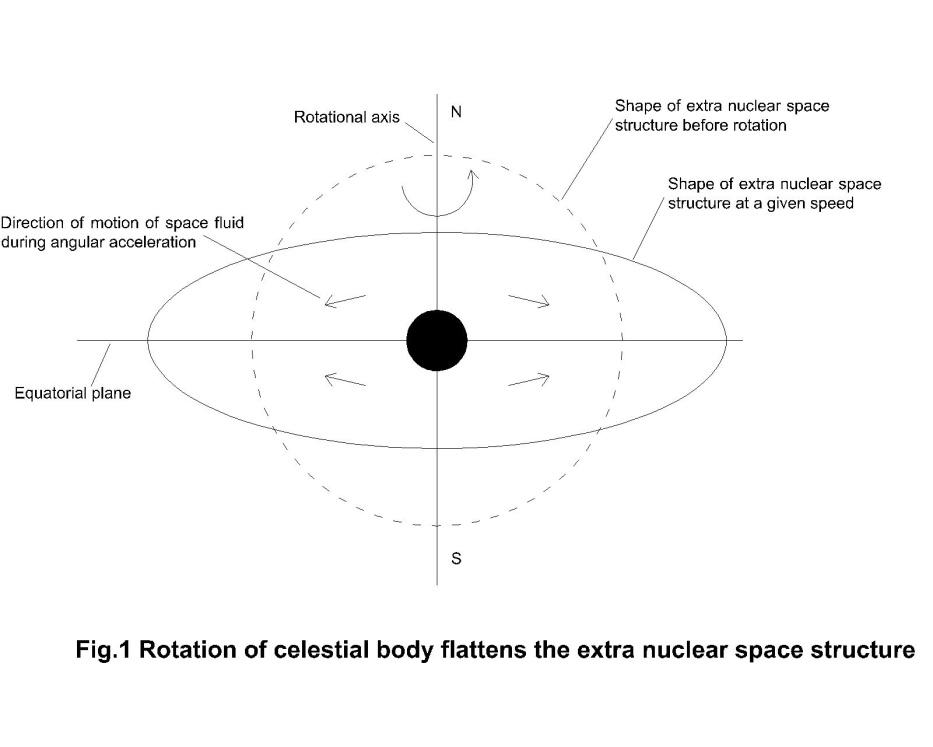
In this new concept, the sun-planet system is visualized in a different manner. The rotating planet with its flattened extra-nuclear space structures are housed within the spinning extra nuclear space structure of the sun (Fig.2). The planets are swept by the spinning extra nuclear space structure of the sun which results in the orbital motion of planets around the sun. This makes all planets to revolve round the sun (orbit the sun) in the same direction as the direction of rotation of the sun. The planets with their flattened extra nuclear space structures when revolve within the spinning extra nuclear space structure of the sun, the flatten faces of the planet remain parallel to the spatial spinning velocity vectors of adjacent space fluid of the sun for minimum resistance. This makes the axis of the orbital body to remain close to perpendicular to the equatorial plane of the central body. All planets located within the spinning extra nuclear space structure of the sun have their axes close to normal to the equatorial plane of the sun as the stable equilibrium position.
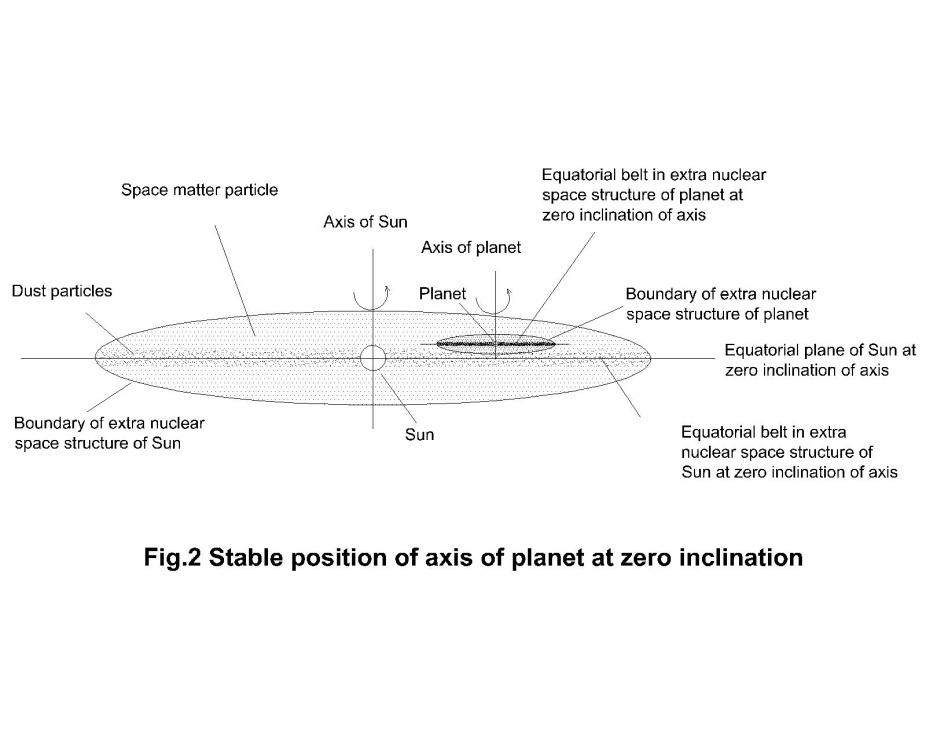
It is not possible to justify the fixed inclination of the axis of the earth pointing the North Pole towards the Polaris star from the gravity-based dynamics of orbital bodies. On the other hand, the dynamics of orbital motion relative to the Sun and the oscillation of the axis relative to the Sun can be worked out by identifying new force interactions. To understand the dynamics of oscillation we require the knowledge of an additional force interaction since gravity alone is not enough for the dynamics. The newly identified non-electric charges (celestial charge & photonic charge) [3] are instrumental in justifying the perpetual oscillation of the axis of the earth. This is dealt in a separate article in this issue of the journal by the author. According to the author, the period of oscillation of the axis and the period of revolution of the earth being the same results in a fixed inclination of the axis of earth with reference to distant stars. Hence, the identified fixed inclination of the axes of other planets reveals the reality of oscillation of their axes with respect to the axis of the sun. It is further noticed that the inclination of axes of different planets has a directional coherence which imply the oscillations of planets are caused by the common spinning space fluid. The oscillation of the axis of a planet makes oscillation of the associated flattened extra nuclear space structure (fig.3).
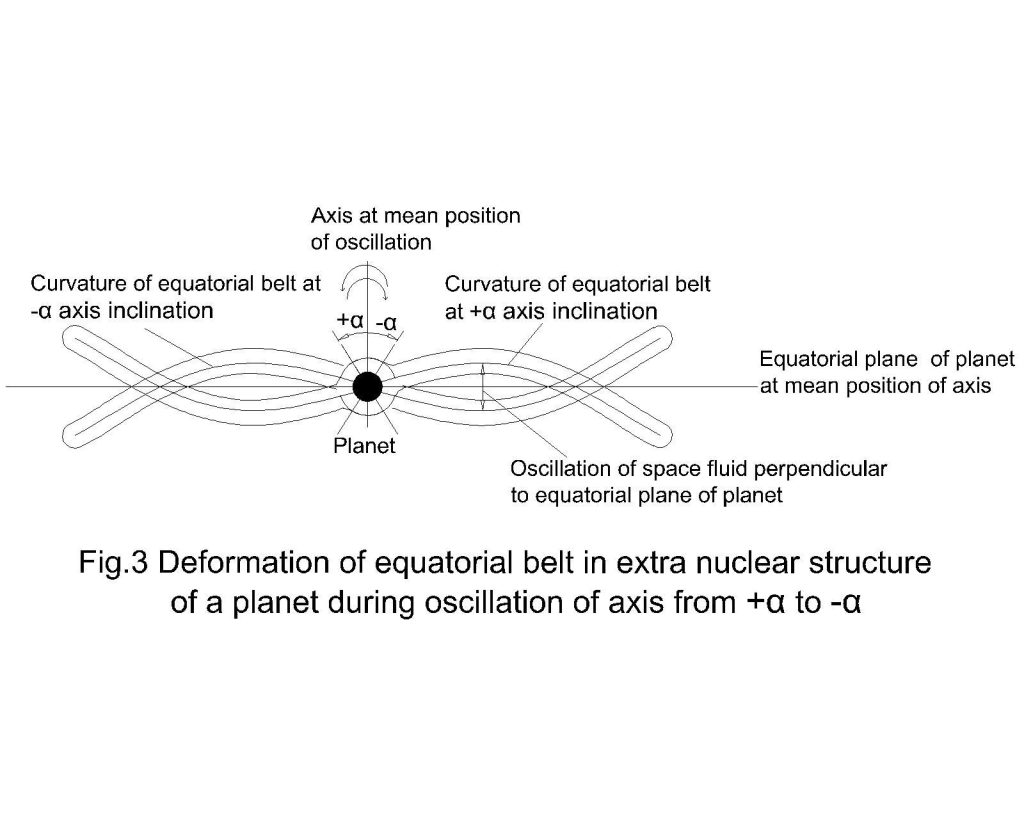
The satellites of a planet are housed in the equatorial belt of the planet. The satellites in equatorial belt of a planet tend to make linear oscillation perpendicular to the equatorial plane of planet due to drag of oscillatory motion of space fluid. For a hypothetical mass less satellite, the amplitude of linear oscillation is same as the amplitude of its adjacent space fluid. But for a mass bearing satellite, the amplitude of oscillation is considerably less than that of the hypothetical mass less satellite due to inertia of rest. The spinning of extranuclear space structure of planet is in such a manner that every space pocket spin in planes parallel to the equatorial plane of the planet (fig.4).
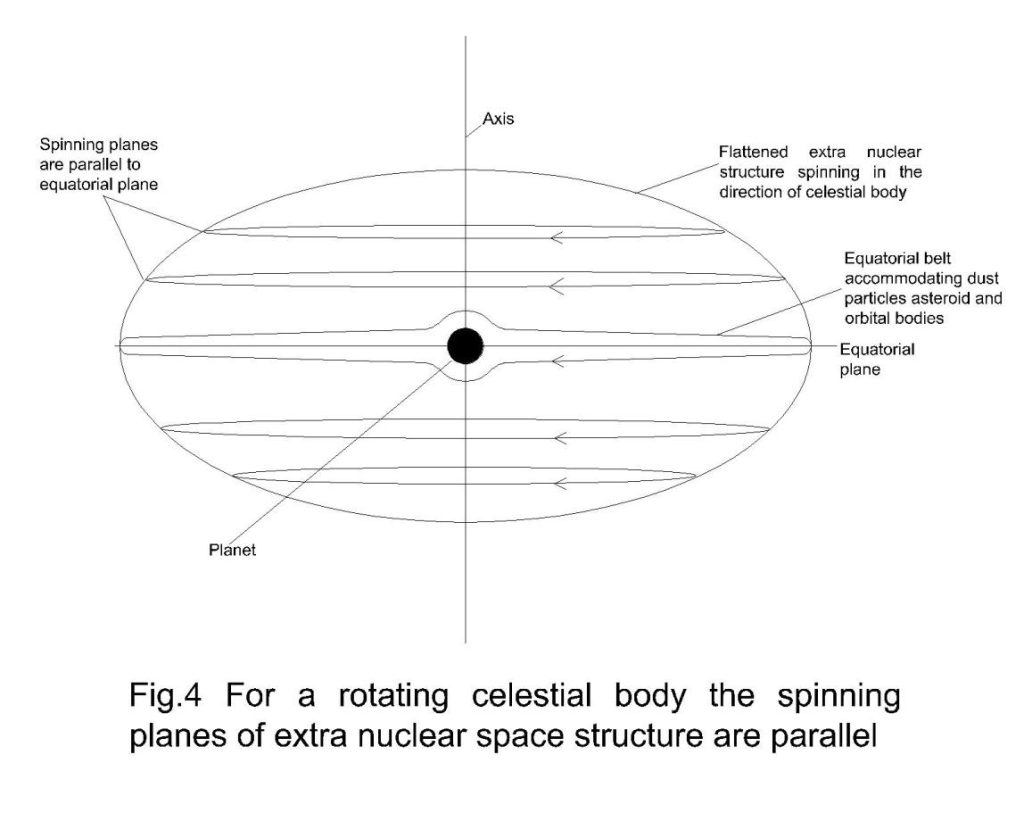
Oscillation of the axis of the planet about its mean position makes the satellites to oscillate in curvilinear path perpendicular to equatorial plane of planet corresponding to the mean position of axis resulting fixed inclination at extreme point of oscillation (fig.5). The inclination of the axis of the satellite is a function of mass of the satellite. For a mass-less satellite the axis takes the position-2, but for a massive satellite the inclination is expected to remain unchanged (position-1) during revolution in the inclined plane. However, the interaction of the spinning fluid of the planet with the spinning fluid of the satellite makes changes in the position-1 by taking to position-3. Over and above the inclination of position-3, the angle of inclination is increased by the celestial charge interaction [3] initiated by this oscillation. The oscillation of the axis about mean position would have slowed down due to different resistive forces of fluid interaction but is maintained endlessly due to torque reversal in celestial charge interaction.
The planets are orbital bodies of the sun. The axis of the sun is inclined at 60 degrees to the galactic plane which implies the axis of the sun also oscillates like the oscillation of the axis of the earth. Therefore, the oscillation of the axis of the sun produces oscillation of the axes of planets at different amplitudes depending on the mass factor resulting in a different inclination of the axes of the planet. The dynamics of fixed inclination of axes of planets is similar to the dynamics of the axes of satellites discussed above.
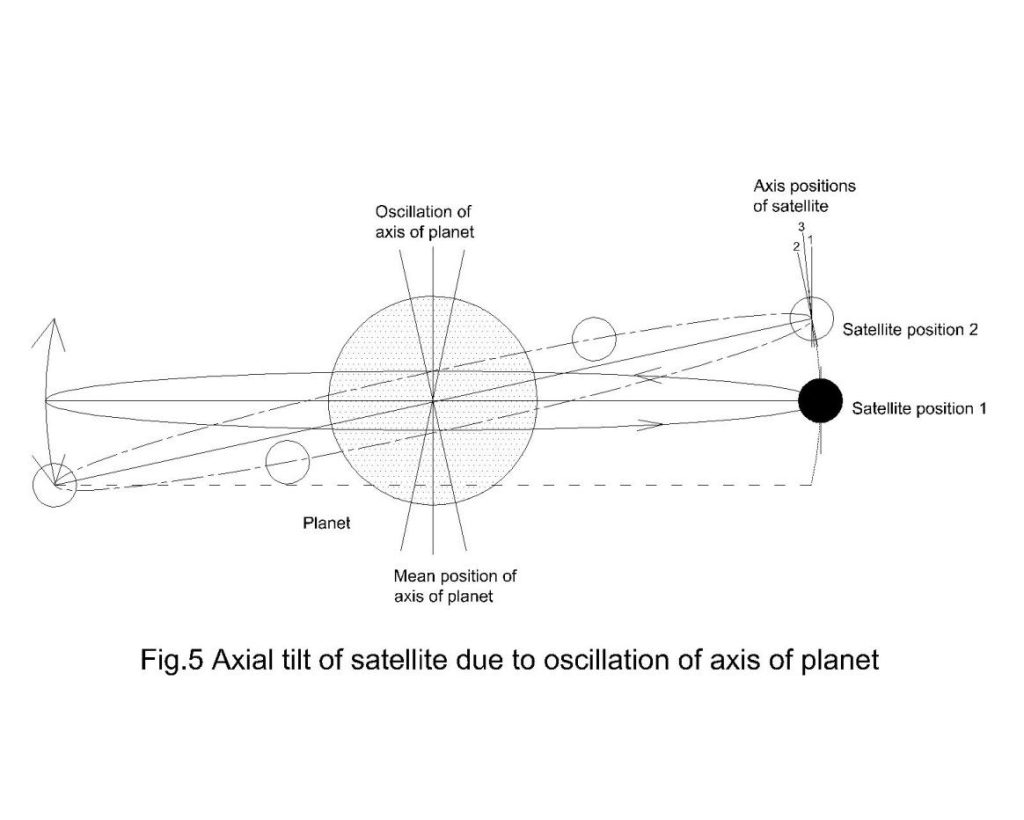
Conclusion
The inclinations of rotational axes of planets and satellites are characterized with reference to their respective orbital planes. We have simply recorded the inclinations of the axis without analysis of their cause. It is more so when we notice most inclinations are small acute angles. The fluid dynamics model of the solar system has a greater scope of understanding different motions of celestial bodies. This article justifies the cause of inclination of rotational axes of planets and satellites. Hence, the state of inclination of the axis is caused due to the effect of fluid dynamics and not a continuation of its state of inertia from the time of its formation.
